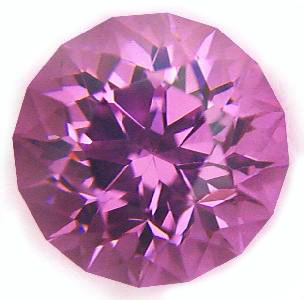
Yttrium aluminum garnet (YAG) first appeared on the market in the early 1960's. The GIA laboratories examined this material in cut form in 1964. It is manufactured by the Linde division of Union Carbide, the Airtron division of Litton Industries, Raytheon and Crystal Optics and was first applied for industrial use in laser research and as an acoustical microwave delay line in communications. It was some time before its applicability in the jewelry industry was fully realized.
The methods employed for production are the Czochrolski "pulling" technique (developed in 1918), and very rarely, the flux-melt method. In essence, the pulling method begins with a small seed crystal which is carefully lowered so as just to touch the surface of molten material. Melting points of approximately 1980°C (near 3600°F) are reached as the seed is rotated and slowly raised producing a long rod-like crystal. Growth is accomplished at the rate of 2 to 6 mm per hour with the boules being one inch or larger in diameter. Since rotation is involved, the boules exhibit a series of more or less pronounced growth rings (see Figure 29).
Flux-grown material yields only small crystals. The growth temperatures are lower than in the pulling method and growth is much slower. The crystals show perfect faces of dodecahedron and trapezohedron as in natural garnets. It should be noted that true garnets which are silicates have been synthesized in many laboratories of the world, although not in commercial quantities. YAG which is a man-made gemstone material does not reproduce anything known in nature, and even though it has a garnet structure, it lacks any silica in its composition. Therefore, YAG's chemical composition is different from garnet which contains silica.
The majority of this gem material on the market is colorless, and is promoted as a diamond substitute under names including Diamanite, Diamonair, Diamonique, Diamonte , Di'Yag, Geminair, Linde Simulated Diamond and Triamond. Many different impurities or dopants may be used to produce a variety of colors including green (chromium), yellow (titanium), red (manganese), blue (cobalt) and purple (neodymium).
Yttrium-aluminum garnet is isotropic and has a refractive index of 1.833; its specific gravity is 4.55; the dispersion measures .28, and its hardness is between 8 to 8-1/2. The luster is sub-adamantine; it takes an excellent polish and has moderate brittleness. The cut material will display some fire if it is cut to good proportions (see Figure 30).
When testing for separations; cut YAG may be viewed parallel to the girdle and will lack the brilliance of a diamond; in addition, upon immersion in a high-index liquid it wilt become transparent and practically disappear from view; even in water, it loses most of its brilliancy. It will also show a conchoidal fracture, as opposed to the splintery fracture of diamond. Despite the fact that cutters may incorporate, a bit of "skin" on the girdle resembling naturals of a diamond, close microscopic examination will disclose their true nature (Figure 31).
The majority of specimens are clean, but when internal characteristics are present, they include gas bubbles, irregular appearing fingerprints and spherical or tube-like inclusions (see Figure 32).
The green material will often show a rather strong curved striae, with a superimposed irregular structure which may be seen at right angles to the curved striae (Figure 33).
Although not always present, the colorless specimens often display a yellow to orange fluorescence under long-wave ultraviolet, and under X-rays a bright mauve. Employment of the Chelsea color filter-with the green stones will show the transmitted light to be red. Depending upon the coloration agent used, the absorption spectra will vary greatly, and those of the yellow and green materials are shown in Figure 34 and 35.
An additional garnet-like synthetic that warrants notation is yttrium oxide. As with YAG, this material is cubic in crystallization, and may well be another promising diamond substitute. Its refractive index is 1.92, the dispersion is .050, and its density is 4.84; with a hardness measuring between 7-1/2 to 8, it takes a high polish.
GADOLINIUM GALLIUM GARNET (GGG)
Gadolinium gallium garnet, a man-made gem material is commonly seen
in the trade as a diamond stimulant often called GGG or 3G. It is singly
refractive with an refractive index of 2.03, specific gravity 7.05,
dispersion 0.038 and the hardness is 6-3/4. The strong orange
fluorescence of gadolinium gallium garnet under short-wave ultraviolet
aids in identification. This gem material is manufactured
by the Czochralski method.

